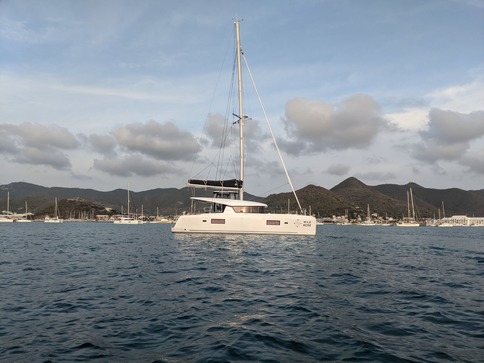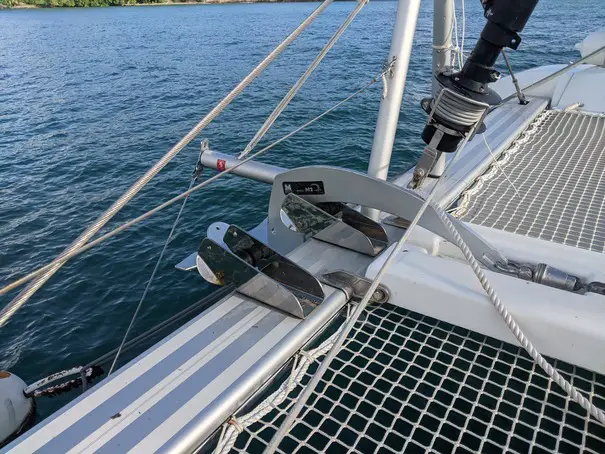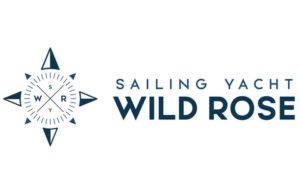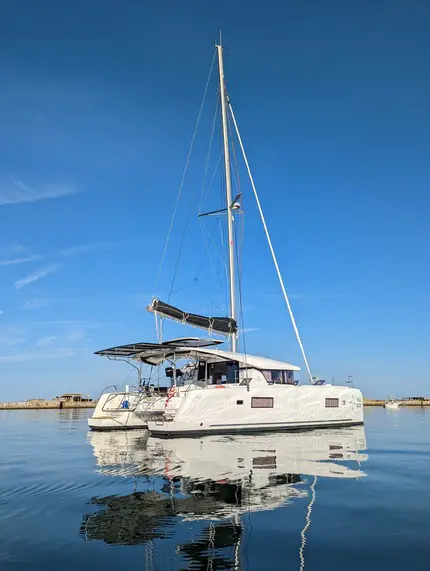When you start out cruising there are a lot of questions you will have. Everything from anchoring to courtesy flag etiquette to check in protocol.
One of the questions I often get from non or new sailors is can you anchor anywhere overnight. As a matter of fact a few months ago we had some crew (guests) on board and we sailed several hours to an area with only one anchorage suitable for the wind direction and conditions we were experiencing that particular day. When we got to the anchorage it was absolutely chocked full of crap pots and there was nowhere to anchor. We had to sail another few hours to get to the next closest anchorage to spend the night. One of our crew said “can’t we just go over there and anchor?” ‘Over there’ offered no protection from the wind and waves and we would have gotten no sleep or worse dragged on to a lee shore.
No, you cannot just anchor a boat anywhere overnight. As a matter of fact there are a lot of considerations to where you can anchor.
Weather
One of the most important factors on where you are going to anchor should be the wind strength and direction. If you are expecting 40 knot winds but you are in the lee of a mountainous island surrounded by three sides of land you’re probably going to have a really good night’s sleep. On the other hand if you are in a roadstead with no protection and the wind shifts blowing you on shore it’s probably not going to be pleasant.
Wind direction is probably the factor we look at most when choosing a suitable anchorage for the night. Not usually for the wind, but for the waves it produces.

Traffic
No one likes to anchor where there is a lot of traffic. Even worse is anchoring in a navigation channel or even an area that is not marked but still has a lot of traffic. Be aware that fishermen and commercial traffic happens at all hours of the day and night when choosing a suitable anchorage.
Bottom Composition
Bottom composition is pretty important when choosing an anchorage for the night. My preferred medium is deep sand, but mud is ok too. Areas to avoid are sea grass, coral, thin sand layer over hard bottom, oyster beds, etc. There is a nice anchorage in the Chesapeake we like that is an oyster bed. The holding isn’t great but if we get dug in well it works. We just have to watch out for wind shifts.
Tide
Some areas of the world have very little tide, and some have a lot. The two main factors to consider with tide are the sea level rise and drop and the current it produces. In many areas the further you get from the equator the more the tide rises and falls. Some anchorages will be void of water at low tide, and some will lift you so much that you won’t have enough anchor rode out.
Some areas of the world have current that will swing you 180 degrees in the opposite direction. These are factors you need to watch out for when choosing an anchorage.
Charts and Cruising Guides
When you first start to cruise on a boat, you are going to question where you can anchor. This is a huge part of planning consideration. My best advice when starting out is to consult your charts and cruising guides. Charts will have an anchor sign on it if it is a known and proven anchorage. Now just because you can anchor there doesn’t mean you should, it’s just a sign that it’s legal to anchor there, people anchor there a lot and it is ok to do so. You still need to weigh all of the other factors on this list to determine if you want to or not.
Cruising guides are better than charts, because they give you local knowledge that charts don’t have. If you’ve never read one, they give you information on anchorages, what wind direction they are suitable in, bottom type, local services such as marinas and restaurants, and other things to do in the area. Cruising guides are a great resource, whenever we are going to be in an area for more than a short time we make sure we get a cruising guide for the area if available.
There is more information available on Navionics and other apps and internet forums. You usually need internet connectivity to do this, but we definitely use these resources when researching anchorages. Navionics makes it really easy with their reviews. Navionics also has a way to see where people have anchored with their small anchor signs. I have placed many of these over the years.
Special Considerations
The biggest special consideration we’ve had to deal with are actually anchorages that are next to airports. Some have restrictions for sailboats due to the runway being at the end of the anchorage and the planes coming in so low. Other areas we’ve had to avoid crab pots and other fishing gear placed by commercial fishermen. There’s always something to look out for when choosing an anchorage for the night.
Anchor Watch
Sometimes, usually during stormy or unsettled weather conditions we are best served to keep an anchor watch. If you are expecting extremely high winds, stormy conditions, severe current or other factors such as lots of traffic you may need to stay up all night in shifts to be sure you and your vessel are kept safe and sound. This not only true during the night, but even sometimes in daytime conditions.

Ground Tackle
If you plan to cruise a lot and stay on anchor a lot while cruising you want to make sure you have good ground tackle. Ground tackle is your anchor and rode plus something to let it down and pull it up. You want to have a newer generation anchor like a Mantus or a Rocna, all chain rode and a reliable and well serviced windlass.
We avoid marinas like the plague when out cruising, they are expensive and hot. We have outfitted our boat to live off-grid but we like to also sleep well at night. I sleep a lot more sound knowing that we upgraded the anchor that came with our boat. It’s not only a better design than the anchor that came with the boat, we upgraded in weight of the anchor as well.
Some smaller boats, under 35 feet will not have a windlass or an all chain rode. This is probably fine, but I would want at least 30 – 50 feet of chain.
Anchor Alarms
95% of the time we anchor we set two apps on our phone. The first is Anchor Pro, we have tried out a lot of anchor alarms and mostly they do the same thing, they notify you with an annoying alarm if your boat moves out of a specified area. Basically it’s notifying you if your anchor is dragging. I loathe apps that I have to pay for, but Anchor Pro is worth the few bucks I spent on it.
The other app I set is Navionics. Navionics doesn’t have an anchor alarm, but if you turn it on and zoom in you will see if and how your boat is moving around at anchor. I know a lot of sailors who do this. It works very well.
Have a Backup Plan
In my story above we did not really have a backup plan established of where we would go. We had been to that particular spot once before and spent a couple of wonderful days. It was a great anchorage. We didn’t know that earlier in the summer it is always full of crab pots. Usually when we are out gunkholing and exploring we will look for two or three suitable anchorages as contingencies.
Once when island hopping in the Caribbean we got to a mooring field that was almost full and the one open mooring broke free when we tied up to it and tested it. There was nowhere to go but a three-hour motor at full speed to the north side of the island where we could anchor. We got into the anchorage just as the sun was setting. I love sailing at night, but pulling into an anchorage I’ve never been to at night scares the hell out of me. Especially one guarded by multiple reefs and dodgy unlit navigational markers.
We didn’t have a backup plan on this occurrence and hastily came up with one on the fly that worked out. Now we always try to have a backup plan.
Conclusion
Picking a good anchorage is an art as much as it is a science. Start with known proven anchorages from charts and cruising guides before freelancing and gunkholing. Once you get used to what to look for it will make it much easier.

